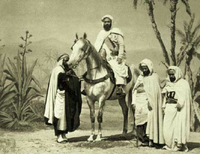| Battle of Bab El Oued | |||||||
|---|---|---|---|---|---|---|---|
| Part of the Algerian War | |||||||
 Modern day view of Bab el Oued | |||||||
| |||||||
| Belligerents | |||||||
|
|
| ||||||
| Commanders and leaders | |||||||
|
|
| ||||||
| Casualties and losses | |||||||
|
15 killed 77 wounded[1] |
20 killed 60 wounded[1] | ||||||
The Battle of Bab el Oued (French: Bataille de Bab el Oued) was a violent confrontation which occurred during the latter stages of the Algerian War (1954–1962) between the French Army and the Organisation armée secrète (OAS) which opposed Algerian independence. It took place in Bab El Oued, then a working-class European quarter of Algiers, from 23 March to 6 April 1962.
Context[edit]
The OAS uprising (19 March)[edit]
The OAS was an organization of hard-line European "Pieds Noirs" living in (the then-French territory) Algeria who were opposed to the cease-fire announced by French president Charles de Gaulle on 19 March 1962 between French forces and the Front de libération nationale (FLN) forces fighting for Algerian Independence. The OAS decided to dig in at their stronghold of Bab El Oued (a traditionally European working-class area) to fight the Evian Agreements by force.
Siege of Bab el Oued (from 23 March to 6 April)[edit]
The Battle of Bab el Oued was principally a battle between the French Gendarmerie Mobile and the OAS Commando Delta. The French government forces used M8 Greyhound armoured cars to control the exits to the town whilst suspicious buildings were surveilled from the air by T-6 and T-28 aircraft departing from Boufarik Air Base. Four T-6s strafed the roofs to clear them from snipers after Army helicopters dropped canisters with tear gas.[2] As part of the attack, naval artillery support from the T 47-class destroyers Surcouf and Maillé-Brézé was planned, though it soon became evident that this was not practical and the bombardment was called off.[3] Most of the troops setting siege to the quarter had been ferried to Algeria by Surcouf and Maillé-Brézé, along with other three destroyers, on 2 March.[4]
In support of Bab-el Oued, 200 OAS maquis marched from Algiers to Ouarsenis, a mountainous region between Oran and Algiers. They tried to capture two French military outposts and gain support from local Muslim tribes loyal to France, but instead these forces were harassed and eventually defeated by French Foreign Legion units led by Colonel Albert Brothier after several days of fighting.[5]
Arrest of General Jouhaud (25 March)[edit]
On 25 March 1962, General Edmond Jouhaud (adjutant to the commander of the OAS Raoul Salan and commander of the OAS-Oranie, the Oran branch of the OAS) was arrested at the Hôtel Panoramic d'Oran with his adjutant, Commander Julien Camelin.
1962 Isly massacre[edit]

The 1962 Isly massacre was an incident which occurred on 26 March 1962 in which a largely peaceful demonstration of anti-independence Pied-Noirs attempted to force their way through French Army roadblocks around the Great Post-Office of Algiers. The demonstrators encountered a roadblock manned by 45 soldiers from the 4th Tirailleur Regiment who fired on the crowd with machine guns. Between 50 and 80 Pied-Noirs demonstrators were killed in the massacre.[6]
Casualties[edit]
According to the historian Benjamin Stora, 15 French soldiers and 20 OAS members were killed during the Battle of Bab el Oued, and around 150 were wounded.[7] Six French soldiers were killed by the OAS in a previous ambush.[8]
References[edit]
- ^ a b Amouroux, Henri and Courrière, Yves (1988). La France contemporaine, La guxrre d'Algérie, t.IX. Tallendier, p.424 (in French)
- ^ Time magazine, Volume 8, p. 119. Time, Inc., 1962
- ^ Roche, Jean-Michel (2010). "Escorteur d'Escadre Surcouf" [Fleet Escort Surcouf] (in French). Netmarine.net. Retrieved 6 May 2016.
- ^ Labour research, Volume 51, p. 112. Labour Research Department, 1962
- ^ Harrison, Alexander (1989). Challenging De Gaulle: The OAS and the counterrevolution in Algeria (1954–1962). Greenwood press, p. 120. ISBN 0-275-92791-1
- ^ Evans, Martin (24 November 2011). Algeria: France's Undeclared War. Oxford University Press. p. 315. ISBN 978-0192803504.
- ^ Benjamin Stora, Les mots de la guerre d'Algérie, Presses Universitaires du Mirail, 2005, p.18 (in French)
- ^ 26 mars 1962, la fusillade de la rue d’Isly à Alger,Ligue des droits de l'homme (LDH, Human Rights League), article based on sources from Benjamin Stora,Histoire de la guerre d'Algérie, La gangrène et l'oubli and Sylvie Thénault, Histoire de la guerre d'indépendance algérienne (in French)
